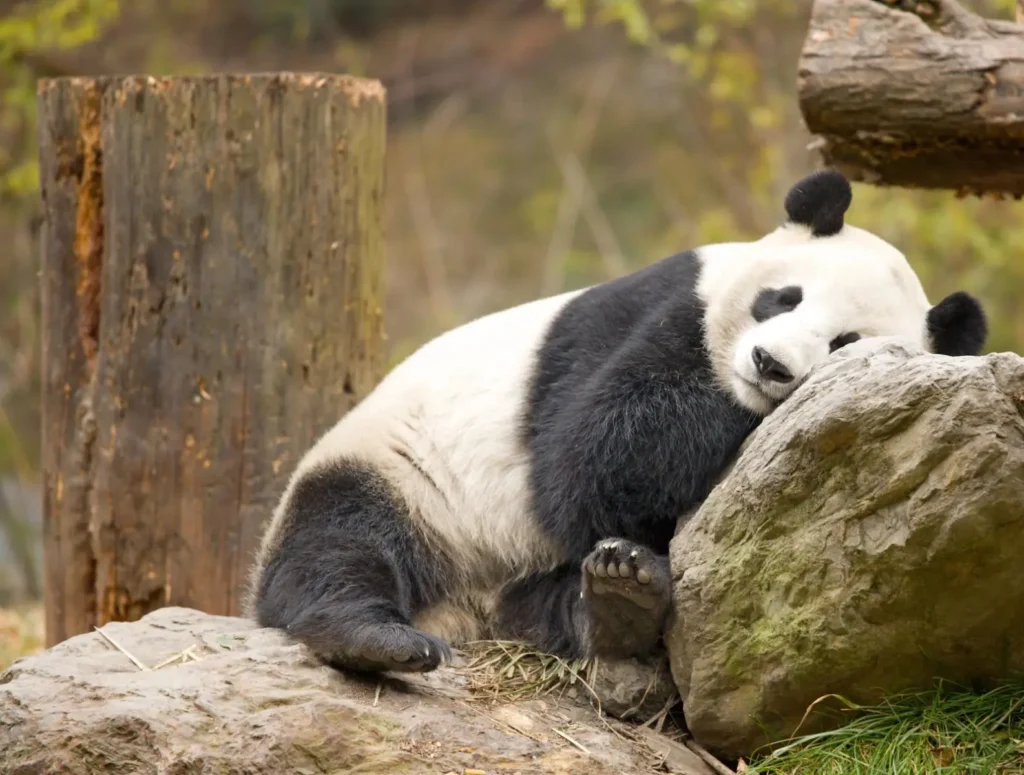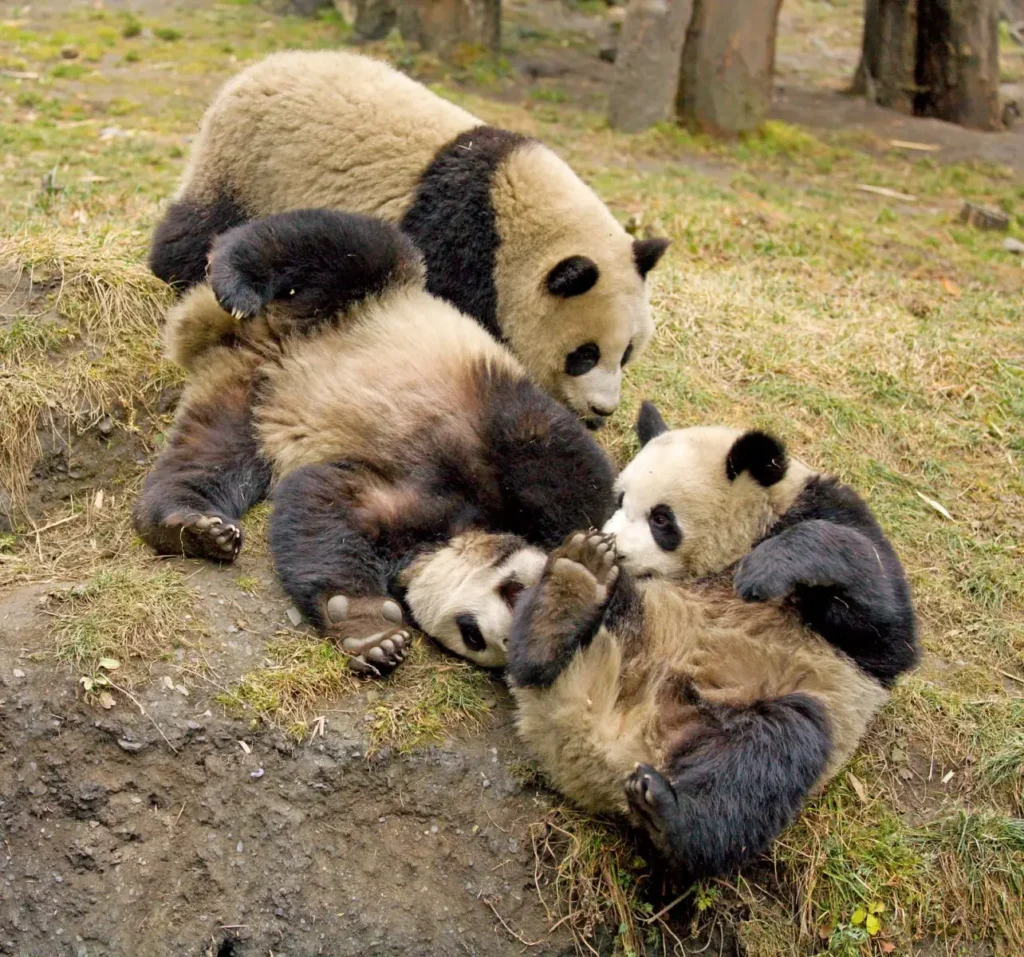Giant panda (Ailuropoda melanoleuca) is one of the most famous and beloved animals in the world. This charming black and white creature has become a symbol of wildlife conservation and the face of conservation organizations, including the World Wide Fund for Nature (WWF).
Despite its cute appearance, the panda is a true carnivore by classification, although its diet consists almost entirely of bamboo. In the wild, it leads a solitary lifestyle and lives in the mountain forests of China. Due to habitat loss and low birth rates, this species was on the verge of extinction, but thanks to active conservation efforts, the situation has improved significantly.
We will take a detailed look at the biological characteristics, behavior, habitat, threats, and conservation measures of giant pandas.

Scientific classification
✔ The Kingdom: Animals (Animalia)
✔ Type: Chordal (Chordata)
✔ Class: Mammals (Mammalia)
✔ Row: Predatory animals (Carnivora)
✔ Family: Bearish (Ursidae)
✔ Gender: Ailuropoda
✔ View: Ailuropoda melanoleuca
🔎 Interestingly, the giant panda's closest relatives are other bears, although for a long time it was considered closer to raccoons.
Appearance and features
✔ Sizes:
• Body length: 120–180 cm
• Height at the shoulders: 60–90 cm
• Weight: 70–125 kg (males are usually larger than females)
✔ Color scheme:
• Distinctive black and white coloration that helps camouflage in snowy and forest conditions
• Black ears and spots around the eyes, which may play a role in communication
✔ Features:
• The big pseudo-finger is a bony outgrowth of the wrist that helps hold bamboo stems
• Strong jaws and powerful teeth, adapted for breaking thick bamboo stems
• Very thick fur that protects against the cold

Habitat and distribution
🌍 Where do giant pandas live?
✔ Mountain forests of central China – Sichuan, Shaanxi and Gansu provinces
✔ Altitudes: from 1200 to 4000 meters above sea level
🔴 Threats to the habitat:
✔ Deforestation of bamboo forests
✔ Habitat fragmentation
✔ Limited number of habitable areas
Social behavior and lifestyle
🔹 Hermitic lifestyle:
✔ Pandas mostly live alone
✔ Males and females only meet during the breeding season
💤 Activity and recreation:
✔ Pandas do not hibernate, unlike other bears
✔ They spend up to 14 hours a day eating bamboo
✔ Most of the rest of the time is spent resting

Diet and nutritional features
🍃 Main food – bamboo (99% of the diet)
✔ Pandas need to eat between 12 and 38 kg of bamboo per day
✔ They choose the juiciest young shoots
🔎 Do pandas eat anything else?
✔ Sometimes they consume:
• Small mammals
• Berries
• Roots
• Eggs
❗ Why is a panda not a predator?
✔ Although it belongs to the carnivorous family, its digestive system is not fully adapted to digest fiber
✔ She needs to consume a huge amount of food to survive
Reproduction and offspring
🐼 How are pandas born?
✔ Pregnancy lasts from 3 to 5 months
✔ The female gives birth to 1–2 cubs, but usually only one survives
✔ A newborn cub weighs only 100–150 grams
🔎 Why are pandas so bad at reproducing?
✔ Females have a short reproductive cycle – only 2–3 days a year when they can become pregnant
✔ In captivity, pandas often show no interest in mating

🐾 Development of cubs:
✔ Babies are born without fur and with their eyes closed
✔ They stay with their mother for up to 1.5 years
✔ Sexual maturity is reached at 5–7 years of age
Threats and conservation of pandas
🔴 Main threats:
✔ Deforestation of bamboo forests
✔ Range fragmentation
✔ Low birth rate
✔ Climate change affecting bamboo growth
🛡 How do you save a panda?
✔ China has created more than 60 nature reserves for pandas
✔ Captive breeding programs have allowed the population to increase
✔ WWF and other organizations are actively raising resources for their protection
📈 Population in the wild:
✔ 1970s: about 1,000 individuals
✔ 2016: over 1864 individuals (species removed from the “endangered” category)
Interesting facts about pandas
🐼 Pandas have a “funny” way of falling – they are very clumsy
🐼 They can stand on their hind legs, but they rarely do so
🐼 Pandas use scents to communicate
🐼 They can bite if they feel threatened
🐼 Their “fingers” are adapted for gripping bamboo stems
Conclusion
The giant panda is a unique animal that has come a long way from extinction to conservation. Thanks to the efforts of scientists and conservation organizations, its population has begun to grow. However, to ensure the future of this species, it is necessary to continue to protect their habitat.
🐼 Do you think that wildlife conservation should be a global priority? Share your thoughts!